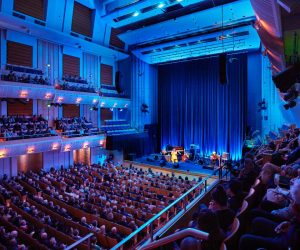
DMX over Ethernet
Lighting control moves with the times.
Text:/ Blake Garner
With every new technology, there seems to be a long period of talk and vague promises before there is any meaningful or tangible development. There has been a lot of excitement over what Ethernet could mean for lighting control for many years now. There have even been a number of products on the market and quite few big budget projects that have take advantage of its capabilities. But despite all this, Ethernet has yet to revolutionise lighting control.
That is beginning to change. Now we have the perfect mix of most mid- to top-end lighting consoles supporting Ethernet, along with affordable and fully-featured DMX-over-Ethernet nodes. Everyone wants to be ready for the gradual but inevitable switch-over. It does have the potential to be a very disruptive and painful transition: new kinds of faults to diagnose, and even more magic boxes with blinking lights. But, as long as the system is well-built, with an understanding of the underlying technologies and protocols in use, the switch-over from DMX to Ethernet should be smooth and straight-forward.
CORE BENEFITS
The core benefit in switching to Ethernet is its ability to handle the increased complexity of modern lighting control systems. DMX512 was never designed to control moving lights or media servers. Capacity for up to 512 dimmer channels seemed like more than enough for any lighting control system but today we have moving lights using 20 to 50 channels each. The current work-around is to employ multiple lines of DMX: a technique that adds complexity to the system and is harder to fault find. Similarly, the simple scale from 0 to 255 to represent the level of each DMX channel is less than ideal for many types of moving light parameters, and is often too granular as well. Lighting console manufacturers find themselves needing to maintain profiles for every single moving light on the market, just so their console can interact with the moving lights in an appropriate manner.
Eventually, the Entertainment Services and Technology Association’s (ESTA) Architecture for Control Networks (ACN) protocol will solve all of these problems, but it is likely to be many years before we see fixture-level control through ACN in mainstream use. In the meantime, there’s the various DMX-over-Ethernet protocols available. Don’t despair that DMX-over-Ethernet equipment will become obsolete, though, even once ACN becomes widely used, DMX-over-Ethernet will continue to be the bridging technology between legacy DMX equipment and Ethernet based systems. DMX-over-Ethernet isn’t just a stepping stone as it does address a few of the problems with DMX: most notably bandwidth. While DMX required separate cables for each universe, DMX-over-Ethernet can send all of it on the one wire.
Unlike DMX-over-Ethernet, DMX only ever allowed one console to be connected to the system. Now that teacher who somehow deletes the patch every time they go near the lighting console can instead use a simple console in the wings, that controls only a few select luminaires, and is automatically disabled as soon as the primary console in the control room is switched on. While a DMX system would require specialist merging equipment and cumbersome additional cabling, a DMX-over-Ethernet system (that supports the appropriate merging rules) can achieve this with no additional hardware or cabling.

THE HARD WAY MADE EASY
In many of today’s systems, Ethernet is implemented as an add-on to the existing DMX system. DMX-over-Ethernet is converted to DMX as soon as it comes out of the desk (or the Ethernet is not even used) and there is generally only a small Ethernet network working alongside the dominant DMX system. As more devices use Ethernet, though, the Ethernet part of the control network will become larger and such a setup will quickly become unworkable.
The solution centres around a system based entirely on Ethernet, that converts to and from DMX only when required. The infrastructure of the venue is entirely Ethernet based, with network ports around the venue wiring back to Ethernet switches set up in the normal star-topology preferred by Ethernet networks. Consoles, fixtures and devices that support Ethernet can plug directly into these ports, while those that only support DMX would connect via nearby DMX-over-Ethernet nodes, such as those made by Artistic License, Enttec or Pathport. These nodes, located in common lighting positions around the venue, are key to the success of the system, as they are the vital transitional link between legacy DMX-only equipment and the modern DMX-over-Ethernet system.
By providing one expandable network that both DMX-over-Ethernet and DMX devices can communicate with, the logistics involved in lighting control wiring is greatly simplified, and can be added to and modified with ease. The trap of two parallel networks (one Ethernet, one DMX) is cleanly avoided. And the same system can even support other control protocols such as tracking backup or even timecode, as well as ACN.
PLUMBED IN?
Integrating the Ethernet network with other devices not related to lighting control, such as an office network or audio system, is also possible, but should generally be avoided. Ensuring that enough bandwidth remains available for lighting communication is paramount for reliable use, and if the network is shared with machines and users outside your control, you can be guaranteed that mid-show your lighting data on the network is going to be disrupted by the FOH staff watching kittens on YouTube, or the mechanists downloading videos of a different kind.
While DMX can daisy-chain, Ethernet equipment should be run in a star configuration. There are now a number of tour-friendly switches emerging with Ethercon points that can hang on a truss and distribute Ethernet out to each device for exactly this purpose. An alternative approach that’s begun to crop up in some fixtures and devices are small, integrated switches that provide the illusion of daisy-chaining by including both an In and a Thru Ethernet port. While this usually works without issue, it’s still best to use a portable switch that stars out to each device, rather than use these built-in switches. Such solutions, especially if ‘looped’ through a number of devices, make the system considerably less robust, and might even introduce noticeable latency between fixtures.
THE PROTOCOLS
As with most new things, a number of people, most notably Strand and ETC, have had a go at producing their own DMX-over-Ethernet protocol, and it’s important to ensure your various DMX-over-Ethernet devices are compatible with the protocol(s) used by your lighting control system. Artistic Licence’s Art-Net is the most widely known and used in the market today. One of the first free-to-use lighting standards, the ease with which it can be implemented has ensured quick uptake from manufacturers. While a solid protocol, it does suffer from a few teething issues. Its reliance on either broadcast or unicast packets makes it somewhat inefficient and its unorthodox approach for allocating IP addresses has always been rather limiting. It is one of the few DMX-over-Ethernet protocols to provide support for both media-server and Remote Device Management (RDM) messages as well as DMX, although there are few products that actually support these parts of the specification. Despite these niggles, it remains a solid communication standard for lighting control.
ESTA’s Lightweight Streaming Protocol for Transport of DMX512 using ACN, more commonly known as Streaming ACN or sACN, is another DMX-over-Ethernet protocol. Designed to be a stepping-stone from DMX-only systems to the Ethernet-only systems ACN will eventually dominate, it has come to market much later than Art-Net, ratified only recently in May 2009. Despite this, it has already seen uptake in a number of popular consoles, being the DMX-over-Ethernet protocol of choice in ETC’s Eos and Congo family and available in other modern consoles such as MA Lighting’s grandMA 2 and Strand’s Palette. Streaming ACN comes with a number of additional benefits over and above those normally found in DMX-over-Ethernet systems, such as the ability to embed merging priority information in the DMX stream itself, as well as being able to transmit both ‘live’ and ‘preview’ DMX streams, useful for sending alternate lighting information (such as blind looks, or the up-coming cue) to the visualiser.
MA Lighting’s MA-Net, used for communication with MA Lighting products, does far more than stream DMX data over Ethernet. Due to the grandMA’s distributed processing architecture, MA-Net not only sends DMX-over-Ethernet, but is also responsible for synchronising nodes and consoles with each other. As a result, MA-Net is an obvious choice when hooking up a system predominantly used for grandMA consoles. In systems that regularly utilise other consoles, a more wide-spread and open protocol such as sACN or Art-Net is a better choice, with MA-Net to be used for synchronisation only when MA Lighting equipment is in use.
BIG SWITCH
It is a tumultuous time for the lighting industry. Lighting consoles increase in complexity considerably with every new release, moving lights contain motorisation and robotics that rival most other industries and simple lighting control systems now involve full-blown Ethernet networks. It’s easy to wonder if the change really is for the better, or are we just making things harder than they need to be. In the end though, the promoters and punters will always want more, which will always lead to more complex systems. The transition to Ethernet is not about replacing a straight-forward technology with one that is tougher to learn. It’s about making a complex system much more manageable. Some of us will need to upgrade our skills to employ Ethernet while others will already be comfortable around it. The good news is that we do not need the same level of training and expertise as a certified IT consultant: basic Ethernet knowledge is fine. All that remains is to ensure that the structure and set-up of the Ethernet system and associated equipment compliments the DMX, rather than opposes it. If we can get that right, the transition from DMX to Ethernet should be a relatively pain-free and pleasant one.















RESPONSES